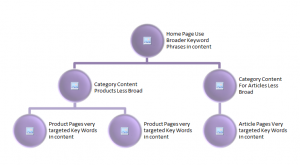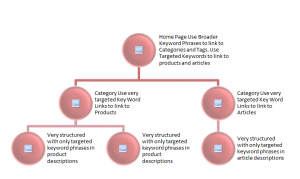WRITING DEEP CONTENT THAT IS INDEXED
“Effective communication is 20% what you know and 80% how you feel about what you know.”
Jim Rohn
The key to picking subject matter varies from website to website. It is very helpful if your website is covering one certain overall theme. For instance if your website is about “Fast Cars” but you also have a side business on “Tasty Cakes” you more than likely would want two different websites to cover those subject materials. The reason why is because of your “Link Strategy” that is indexed by search engines. When linking to irrelevant content from one page to the next you could suffer from being penalized for that. So if I had a website about fast cars and then a link at the top of my website to go to another page that talks about “Tasty Cakes” I am not serving the visitors of my page relevant links or content that is related to the content on my page and therefore I can be penalized for it from a search engines perspective. Yet if I had a web page about “Fast Cars” and then a link to my “Fast engine” page that could help the SERP of my site since I am serving relevant content. Remember it’s all about the subject material and its relevance to that web page. Now let’s examine more in the keyword strategy department.
Content Strategy Breakdown
Picking a Keyword Phrase
Last lesson we learned how to use the keyword planner. This lesson we will examine more about using it to get ideas about keyword phrases that we can use. The best thing that we can do when finding our subject material is to use the search engines themselves like everyone else uses it and see what comes up. Then we will go to the top ranking pages and examine them to see how they are written to get a game plan strategy. We will also take notes of the “Suggested Searches” at the bottom of the page in Google’s search results. This can give us an amazing lead in our research strategy. Remember to make a folder on your desktop and name it whatever you think your keyword phrase will be.
If we go to the Google Search engine and type in “Healthy Diets” and scroll to the bottom of the search results page we will get some suggestions on narrowing our keyword phrase down.
This tool gives us valuable information that we can utilize when we take it to the keyword planner. The strategy here is to start with a broad keyword phrase and start narrowing it down. We never want to use a broad keyword phrase in our articles or product descriptions. There are always ways to narrow down your target phrase and this is just one of those methods. Do repeated searches over and over with variations of what you think may be useful and write down the suggested results to take to the keyword planner. Also click on the suggested search results if they pertain to your product or service and keep track of what they say. The only reason why Google is offering these ideas is because they have them indexed in their search engines. If you are coming up with a new product and you keep with a good strategy plan it could be your product or service that Google suggests at the bottom of the search page. It might be helpful to write down the search result number as well. If Google does not have many results for the terms that means the market could be wide open!
Put your mind in Googles position for a moment and forget about how big of a search engine they are. All they are is a website that indexes other websites. They do have competitors that are breathing down their back like, Bing, Yahoo, Ask and they want to do a better job than those guys. That will force them to find the best most relevant content and serve it to their visitors, if they don’t have it then surfers will use other search engines that do.
Utilizing the Resources
After we have narrowed down a keyword phrase from the suggested method let’s take it to the keyword planner and see how many search results it gets in different markets. I am going to research the term “Healthy Fast Diets” and see what my competition is like in the keyword planner. When I get there and type in my keyword phrase I see these results. The competition is medium but there is a bid on the keyword phrase that is over $3 a click which tells me it might be a little difficult if I am a new site to get indexed for that particular phrase.
When I move down the page I see a suggested keyword phrase, “Healthy Fast Food Meals” there are over 720 searches for this every month and it is low competition with a bid click of $1.99.
This would be a great keyword phrase for me to capitalize on if my website was about a “Healthy Eating Lifestyle”. Now take that keyword phrase back to the search engine and type in, “Healthy Fast Food Meals” and see what comes up. We want to click on the first “Organic Link” to see what our top competition is using. When we do we see an awful website with pop ups, irrelevant ads and more. Yet they have a page rank of 4 which means the site has been around for a little while. Here is the URL structure on the page, http://www.familycircle.com/health/weight-loss/diet-tips/healthy-fast-food/. If we put in “healthy-fast-food-meals’ in our URL you will have a better chance of getting to the first spot. The next thing that we can check is to see how many quality back links are going to the page. If we check the back links we can see that there are 39 external pages referring to this site but it does not look like they are using the keyword phrase in the link. This is also good for us. The Free Backlink Watch and Monitor Tools (linksmanagement.com) website reports that there are no “External” back links which is also good for us. [ii]
Writing the Article
Now we have to go into the next phase or writing the article. Write down your keyword phrase whatever it may be, for our example this is going to be “Healthy Fast Food Meals”. Now we want to answer as many questions as we can. Think of questions by writing down;
- Who
- What
- Where
- When
- Why
- How
Who is an important question. Talk about who can benefit from this article. Possibly lifestyles that are on the go all the time from working mothers to business men.
What is another factor that you should take time to think about answering. What are the items that you are suggesting? What can they do with it? What kind of flavors can they taste?
Where is a good question as well. Can they eat it on their lunch break at work? Is it easy to eat in the car, on the go?
When should this be eaten? Does it need to be cooked possibly in a microwave? When should they eat it during the day to expect the best results?
Why should they eat Healthy Fast Food Meals? Why should they give it to their children, spouse, mom, dad, grandparents?
How should they eat a Healthy Fast Food Meal? How should they serve it? How much should they eat of it? How do they store it if they have some left over or should they store it?
Instructions
- Create a folder on your desktop and label it after your keyword phrase.
- Create an article and answer as many questions that you can think of using the method above.
- Make a short description that sums up your article; make sure that you put a call to attention in it as well. Like “FREE HEALTHY FAST FOOD MEAL PLANS HERE!!!” Eat healthy, live fast! COME AND SEE!
- Next take a bunch of pictures of your subject and store them inside a media folder that is inside the folder on your desktop. You should already have a folder there with your keyword phrase research.
- NOTE: You can rename the folder now to the keyword phrase that you will be using.
- Import all your media to the folder and name the files according to the keyword phrases. A great way to pick variations of your keyword phrase is use the similar terms that are in your keyword list. The main photo should be your keyword phrase exactly. Name the other photos variations of the keyword.
- Upload all your photos to your website or media library. If applicable give them title tags and alt tags named after the keyword phrases from your keyword list. You will be able to do this in a WordPress CMS in the media library.
- Any video that you have made upload to YouTube and other video websites and link them back to your webpage where the article is located, NOT YOUR HOME PAGE!
If you would like to learn more about web development strategy please see Organic Search Engine Optimization Techniques Tutorial
[i] Internal links mean that you are linking to content within your website. External links mean that you are linking to a webpage outside of your website
[ii] You can use the Google Chrome browser extension called Page Rank Status or the Google Chrome SEO toolbar to check out your competitions edge. Scroll to bottom and click click on FREE and add it to your Chrome Toolbar





1 Trackback